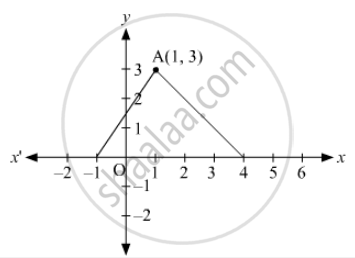Advertisements
Advertisements
Question
If the centroid of the triangle formed by the points (a, b), (b, c) and (c, a) is at the origin, then a3 + b3 + c3 =
Options
abc
0
a + b + c
3 abc
Solution
The co-ordinates of the vertices are (a, b); (b, c) and (c, a)
The co-ordinate of the centroid is (0, 0)
We know that the co-ordinates of the centroid of a triangle whose vertices are `(x_1 ,y_1) ,(x_2 , y_2) ,(x_3 ,y_3)` is
`((x_1 + x_2 + x_3 )/3 , ( y_1 + y_2 + y_3)/ 3)`
So,
`(0,0) = ((a + b + c) /3 , (b + c+a ) /3)`
Compare individual terms on both the sides-
`(a + b + c) / 3 = 0`
Therefore,
`a + b+ c = 0`
We have to find the value of -
`a^3 + b^3 +c^3`
Now as we know that if,
a + b +c = 0
Then,
`a^3 + b^3 +c^3 = 3abc`
APPEARS IN
RELATED QUESTIONS
The coordinates of the point P are (−3, 2). Find the coordinates of the point Q which lies on the line joining P and origin such that OP = OQ.
Find the ratio in which the line segment joining (-2, -3) and (5, 6) is divided by x-axis Also, find the coordinates of the point of division in each case.
If p(x , y) is point equidistant from the points A(6, -1) and B(2,3) A , show that x – y = 3
The base BC of an equilateral triangle ABC lies on y-axis. The coordinates of point C are (0, -3). The origin is the midpoint of the base. Find the coordinates of the points A and B. Also, find the coordinates of another point D such that ABCD is a rhombus.
Find the area of quadrilateral ABCD whose vertices are A(-5, 7), B(-4, -5) C(-1,-6) and D(4,5)
In what ratio does the point C (4,5) divides the join of A (2,3) and B (7,8) ?
The co-ordinates of point A and B are 4 and -8 respectively. Find d(A, B).
The area of the triangle formed by the points A(2,0) B(6,0) and C(4,6) is
Find the value of a for which the area of the triangle formed by the points A(a, 2a), B(−2, 6) and C(3, 1) is 10 square units.
If three points (x1, y1) (x2, y2), (x3, y3) lie on the same line, prove that \[\frac{y_2 - y_3}{x_2 x_3} + \frac{y_3 - y_1}{x_3 x_1} + \frac{y_1 - y_2}{x_1 x_2} = 0\]
If the points A(−1, −4), B(b, c) and C(5, −1) are collinear and 2b + c = 4, find the values of b and c.
If P (x, 6) is the mid-point of the line segment joining A (6, 5) and B (4, y), find y.
If the points A (1,2) , O (0,0) and C (a,b) are collinear , then find a : b.
If (−1, 2), (2, −1) and (3, 1) are any three vertices of a parallelogram, then
If A (5, 3), B (11, −5) and P (12, y) are the vertices of a right triangle right angled at P, then y=
In Fig. 14.46, the area of ΔABC (in square units) is

Write the X-coordinate and Y-coordinate of point P(– 5, 4)
If the coordinates of the two points are P(–2, 3) and Q(–3, 5), then (abscissa of P) – (abscissa of Q) is ______.
The perpendicular distance of the point P(3, 4) from the y-axis is ______.
Co-ordinates of origin are ______.
